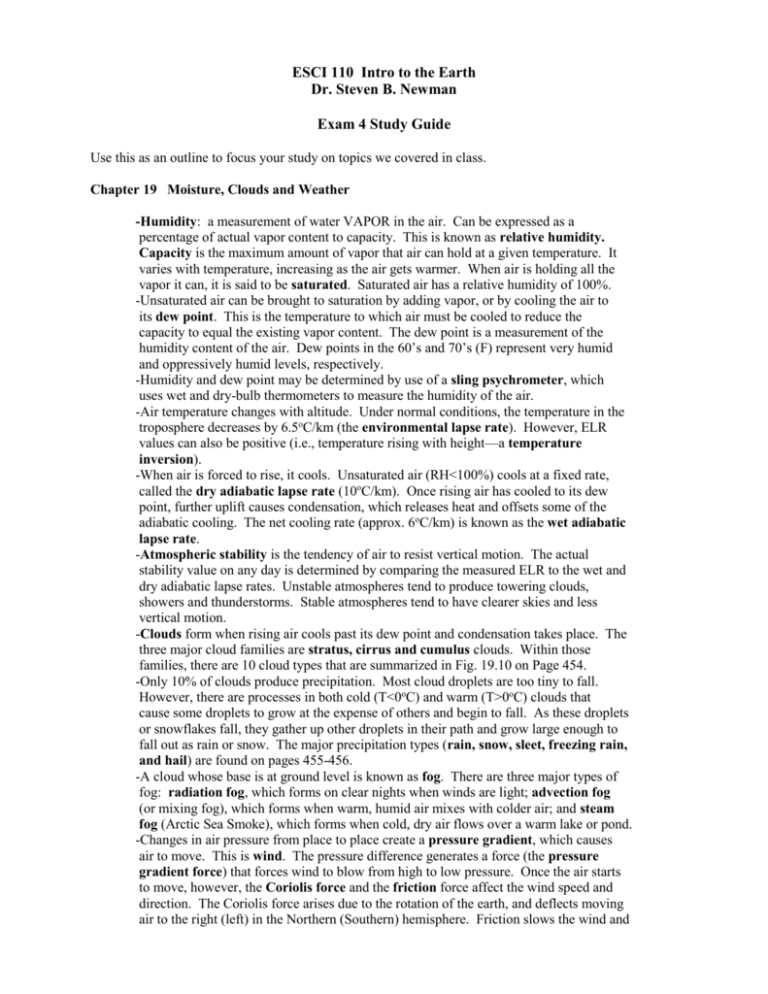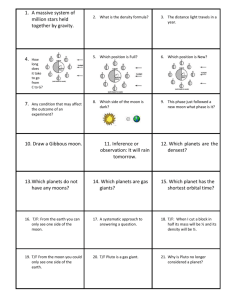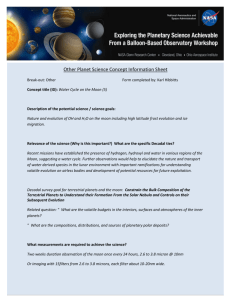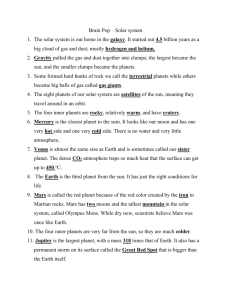ESCI 110 Intro to the Earth
advertisement

ESCI 110 Intro to the Earth Dr. Steven B. Newman Exam 4 Study Guide Use this as an outline to focus your study on topics we covered in class. Chapter 19 Moisture, Clouds and Weather -Humidity: a measurement of water VAPOR in the air. Can be expressed as a percentage of actual vapor content to capacity. This is known as relative humidity. Capacity is the maximum amount of vapor that air can hold at a given temperature. It varies with temperature, increasing as the air gets warmer. When air is holding all the vapor it can, it is said to be saturated. Saturated air has a relative humidity of 100%. -Unsaturated air can be brought to saturation by adding vapor, or by cooling the air to its dew point. This is the temperature to which air must be cooled to reduce the capacity to equal the existing vapor content. The dew point is a measurement of the humidity content of the air. Dew points in the 60’s and 70’s (F) represent very humid and oppressively humid levels, respectively. -Humidity and dew point may be determined by use of a sling psychrometer, which uses wet and dry-bulb thermometers to measure the humidity of the air. -Air temperature changes with altitude. Under normal conditions, the temperature in the troposphere decreases by 6.5oC/km (the environmental lapse rate). However, ELR values can also be positive (i.e., temperature rising with height—a temperature inversion). -When air is forced to rise, it cools. Unsaturated air (RH<100%) cools at a fixed rate, called the dry adiabatic lapse rate (10oC/km). Once rising air has cooled to its dew point, further uplift causes condensation, which releases heat and offsets some of the adiabatic cooling. The net cooling rate (approx. 6oC/km) is known as the wet adiabatic lapse rate. -Atmospheric stability is the tendency of air to resist vertical motion. The actual stability value on any day is determined by comparing the measured ELR to the wet and dry adiabatic lapse rates. Unstable atmospheres tend to produce towering clouds, showers and thunderstorms. Stable atmospheres tend to have clearer skies and less vertical motion. -Clouds form when rising air cools past its dew point and condensation takes place. The three major cloud families are stratus, cirrus and cumulus clouds. Within those families, there are 10 cloud types that are summarized in Fig. 19.10 on Page 454. -Only 10% of clouds produce precipitation. Most cloud droplets are too tiny to fall. However, there are processes in both cold (T<0oC) and warm (T>0oC) clouds that cause some droplets to grow at the expense of others and begin to fall. As these droplets or snowflakes fall, they gather up other droplets in their path and grow large enough to fall out as rain or snow. The major precipitation types (rain, snow, sleet, freezing rain, and hail) are found on pages 455-456. -A cloud whose base is at ground level is known as fog. There are three major types of fog: radiation fog, which forms on clear nights when winds are light; advection fog (or mixing fog), which forms when warm, humid air mixes with colder air; and steam fog (Arctic Sea Smoke), which forms when cold, dry air flows over a warm lake or pond. -Changes in air pressure from place to place create a pressure gradient, which causes air to move. This is wind. The pressure difference generates a force (the pressure gradient force) that forces wind to blow from high to low pressure. Once the air starts to move, however, the Coriolis force and the friction force affect the wind speed and direction. The Coriolis force arises due to the rotation of the earth, and deflects moving air to the right (left) in the Northern (Southern) hemisphere. Friction slows the wind and causes it to spiral into low pressure systems and out from high pressure systems. Lows rotate counterclockwise and highs rotate clockwise in the Northern hemisphere. The rotations are opposite in the Southern hemisphere. -The inward spiral in Lows causes air to converge at the center and rise, resulting in cloudiness and precipitation. In Highs, the outward spiral from the center results in divergence and sinking air at the center, leading to lower relative humidity and clear skies. -Air masses are large bodies of air that have similar temperature and humidity properties throughout their extent. There are four major air mass types affecting the U.S. They are summarized in Table 19.1 on page 462. -Weather fronts are the boundaries that separate air masses. They are named for the temperatures behind them. Cold fronts represent the leading edge of polar air. Warm fronts represent the leading edge of tropical air. Occluded fronts occur when cold fronts (which move faster) catch up with warm fronts. Diagrams of each, and the weather that is associated with them are on pages 463 and 464. -Mid-latitude cyclones(lows) form when waves on the Polar Front develop into rotating weather systems. As the wave grows, the polar front breaks into a cold and warm front, with lowest pressure at the apex of the wave. As the low evolves, the occlusion process begins and the storm fills in. The entire process usually lasts 4-5 days. -Local circulations such as sea breezes and land breezes are the result of temperature differences between land and water. At the height of the afternoon, the sea breeze blows cool air onshore. The breeze is strongest when the temperature difference is largest. At night, the temperature difference is reversed (land cooler than water) and a weak land breeze develops. -Monsoon circulation is a seasonal wind reversal. It is most common in India, where winter is very dry with no rainfall at all, while summer features three months when over 300 inches of rain may fall. -Thunderstorms result from heat, humidity, instability and vertical uplift. They can grow to heights of up to 20 km. Air mass storms occur within a mT air mass and are usually scattered and not intense. Frontal storms are more intense and occur along cold fronts (squall lines). They are more likely to produce tornadoes and hail. Air mass storms go through three stages (cumulus stage, mature stage, dissipating stage), The heavy rain, lightning, thunder, and gusty winds all occur primarily during the mature stage. Lightning is a giant spark of static electricity caused when negative charges at the base of the thunderstorm jump across the gap to neutralize positive charges in the ground below. Lightning heats the surrounding air to temperatures up to 30,000oC. The rapid heating of the air causes a shock wave (sound wave) that travels away from the lightning channel. This is what we hear as thunder. Thunderstorms can cause flash flooding, high winds, hail and downbursts. -Frontal storms may also produce tornadoes. The tornado is a high speed column of rotating air. Wind speeds may exceed 250 mph. Tornadoes are classified using the Fujita Scale, which runs from F0 to F5. F5 tornadoes are the rarest. Tornadoes form primarily in the Midwestern part of the U.S. (Tornado Alley—TX, OK, KS, NE). There are around 1000 per year, mostly in the months from April to June. They require warm humid air at the surface, and cold dry air aloft. The mountains in the eastern and western U.S. trap these air masses and allow tornadoes to form. -Hurricanes (tropical cyclones) are larger storms that feature ultra-low pressure in the center, no fronts and only one air mass (mT). They form primarily from June to November in the tropical Atlantic and Caribbean. They go through a life cycle that begins with a tropical disturbance, develops into a tropical depression, then a tropical storm (winds 39-72 mph, and given a name) and finally a hurricane (winds >72 mph). Hurricanes are classified using the Saffir-Simpson Scale, from Category 1 to Category 5. The entire scale is found on page 473. -Worldwide weather can be affected by changes in ocean currents. One such change is a current off the South American coast known as El Niño. The development of an El Niño can cause weather changes all over the world, including droughts and additional Storminess (especially across the southern U.S. in winter). Chapter 22 Motions in the Heavens -Constellations are patterns of stars in the sky. There are approximately 88 different constellations. However, the stars making up a constellation are NOT connected or related to one another. Stars seem to revolve around the earth, moving from east to west. Planets, however, seem to pause in their westward motion and move back to the east before resuming. This is called retrograde motion and is related to the way in which we see planets against the background of stars. -Early astronomers believed the earth was at the center of the universe (geocentric). Some early Greek astronomers were able to explain the phases of the moon, and the circumference of the earth. However, most believed the earth was at the center, and the work of Ptolemy, which explained retrograde motion (incorrectly) for the first time led to that belief persisting for 1300 years. -Modern astronomers (Copernicus, Tycho, Kepler, Galileo and Newton) began to challenge these views in the late 1400s. The heliocentric (sun-centered) universe was first proposed by Copernicus. Kepler developed the Laws of Planetary Motion from 1609 to 1619. Galileo discovered the rings of Saturn, the largest moons of Jupiter and the sunspots with his telescope. Newton developed the Law of Universal Gravitiation. -The phases of the moon result from the revolution of the moon around the earth, combined with the light from the sun. A synodic month, as seen from earth lasts 29 ½ days (new moon to new moon). -Solar eclipses occur when the shadow of the moon is cast on the earth. Only a narrow band on earth is under the total shadow, and sees a total solar eclipse, which can only occur at new moon. A lunar eclipse occurs when the full moon passes through the shadow of the earth. The moon glows coppery red during the totality phase. -Astronomers use two types of optical telescopes to observe the heavens. Refracting telescopes use two lenses to magnify objects at great distances. Reflecting telescopes use a mirror to collect light and send it to a lens that magnifies the object. Each type has plusses and minuses that argue in its favor. Radio telescopes detect non-optical wavelengths and are used to study X-rays and Gamma rays from interstellar objects. Chapter 23 Planets and Their Moons -Astronomers believe the solar system is approximately 4.5 billion years old. It may have formed when a cloud of cosmic gas and dust began rotating and formed into a disk. The collapsing disk condensed into a protosun, which threw off clumps of material (protoplanets). The four innermost planets are the terrestrial planets. The next four planets are the Jovian planets. Beyond that are Pluto and a new unnamed tenth planet. -Mercury is the closest terrestrial planet to the sun. It has no atmosphere and orbits the sun in only 88 days. Venus is the second planet. It is almost a twin to earth, but is shrouded in thick clouds of CO2 which hide its surface. Radar mapping has allowed astronomers to generate a map of Venus. It is volcanically and tectonically active. The high concentration of CO2 (97% of the atmosphere) has resulted in a runaway greenhouse effect and high surface temperatures and pressures. The Moon is our nearest neighbor. It has both mountainous regions (lunar highlands) and flat lava plains (lunar maria—“seas”). The maria are composed of basaltic rock, while the highlands are older and composed primarily of granitic rock. It appears to be both geologically and tectonically dead at this time. Current thinking is that the Moon was formed early in the solar system life when a large asteroid collided with earth, taking a chunk of molten material out of the earth and leaving it in orbit. Mars is the last of the terrestrial planets. It features huge shield volcanoes (Olympus Mons) and deep canyons (Valles Marineris). It has a thin atmosphere that is mostly CO2. Currently it is being explored by two surface probes, Spirit and Opportunity, that have sent back thousands of pictures of the Martian surface. Mars has two moons, Deimos and Phobos, the only other moons among the terrestrial planets. -Asteroids are small rocks and boulders that are found in the gap between Mars and Jupiter. They are probably leftover bits of material that never condensed into a planet. Some have come close to, and others have, in fact, collided with the earth. -Jupiter is the largest planet in the solar system. Its atmosphere is composed of hydrogen, helium and ammonia. The Great Red Spot is a large rotating hurricanelike storm in the Jovian atmosphere. The four largest moons are the Galilean moons. Of these, only Io is known to have volcanic eruptions occurring at present. Saturn has a vast ring system (as do the other Jovian planets) made up of billions of small rocks and dust particles that reflect sunlight. Currently, the Cassini-Huygens space probe is exploring the region around Saturn. A part of the Huygens probe soft-landed on Titan, the only moon in the solar system known to have an atmosphere. Both Jupiter and Saturn and their moons were photographed close-up by the Voyager space probes from 1979-1981. -Uranus and Neptune are Jovian twins. Their atmospheres are primarily methane, which gives them their greenish-blue color. Uranus rotates on its side (its axis is inclined 82o from vertical. Both planets have ring systems. Neptune’s largest moon, Triton is unusual in that it revolves around Neptune in the opposite direction to the planet’s rotation. This may indicate that it was a captured moon, not an original one. The temperature on Triton is a chilly -391oF, the coldest in the solar system. -Pluto was discovered in 1931 by Clyde Tombaugh. It is smaller than the Moon. Most likely, Pluto was a moon of Neptune that went into its own solar orbit after colliding with another object. It has two moons of its own. The larger one, Charon, may have been a part of Pluto that broke off in the collision. Pluto’s orbit actually crosses the orbit of Neptune, which would support the theory that it was once a Neptune moon. During the Summer of 2006, the International Astronomical Union re-designated Pluto as a “dwarf planet,” and removed it from the list of “classical planets.” Thus there are now eight classical planets. -A tenth planet was discovered in 2005. It has now officially been named Eris after originally being referred to as 2003 UB313. It is also considered one of the “dwarf planets.” Its orbit is highly elliptical, coming as close as 3.5 billion miles and as far as 9 billion miles from the sun. Its orbital period is over 500 years, and it appears to have one small moon, which has been named Dysnomia. -Comets are often referred to as “dirty snowballs.” They originate beyond the orbit of Pluto in a region known as the Oort Cloud. As they fall toward the sun, bits of their icy coating vaporize in the solar wind, creating the comet’s tail. The rock at the center is the nucleus, and the dust cloud around the nucleus are known as the coma. Together, the nucleus and coma make up the comet’s head. The most famous comet of all is Halley’s Comet, which returns to the earth every 76 years. It’s next appearance will be in 2061. -Meteors are streaks of light made by tiny particles (meteoroids) that burn up in the earth’s atmosphere. Most are completely vaporized, but some are large enough to reach the earth as meteorites. Meteor showers are swarms of meteors that appear in the night sky. They are often associated with the debris left in the trail of a comet’s path. Depending on composition, meteorites are stony (mostly rock), iron (mostly iron) or stony-iron (a combination of both). Recently, astronomers have discovered organic material in some meteorites, which supports the idea that meteorites provided the organic “seeds” for life on Earth.









